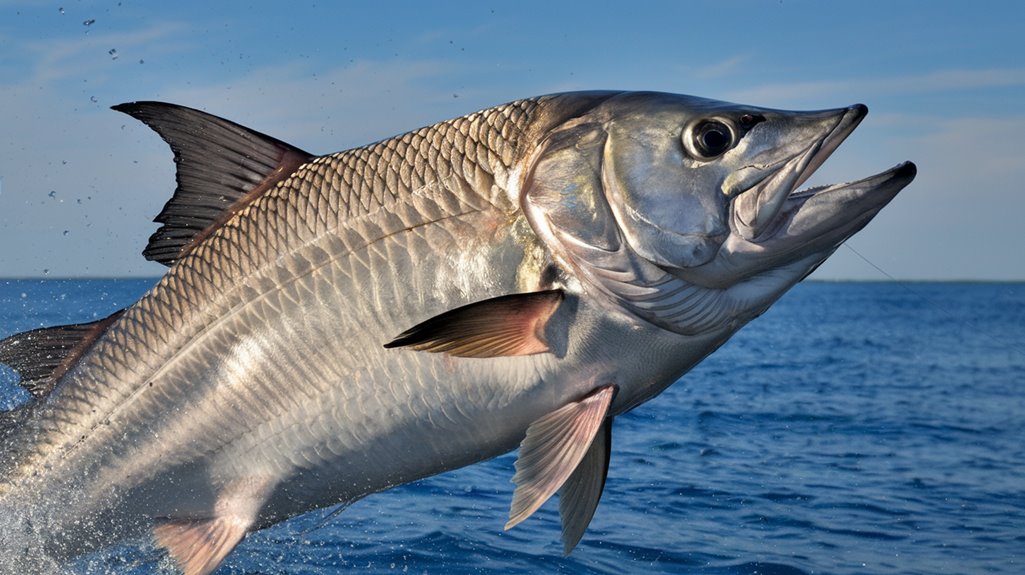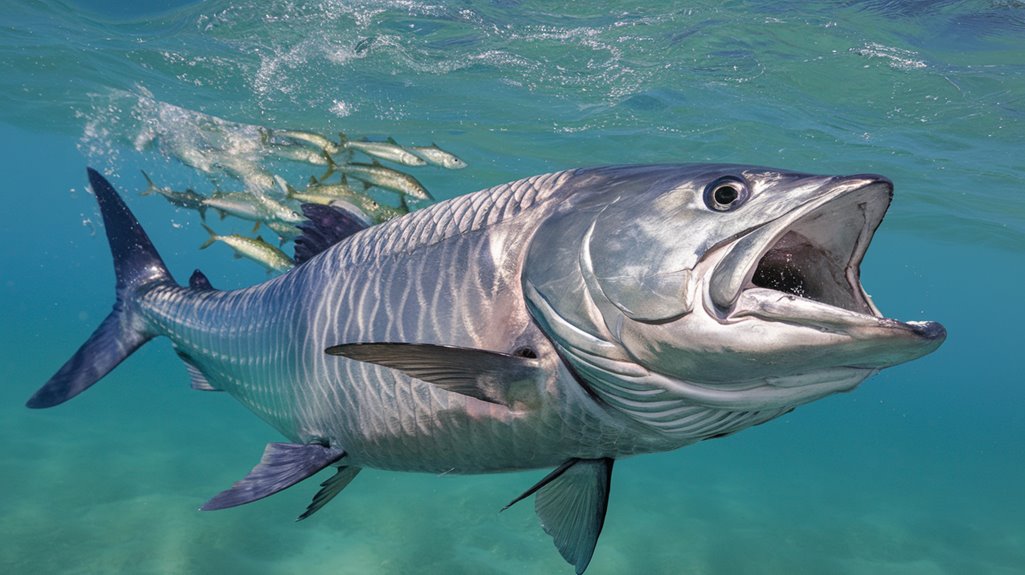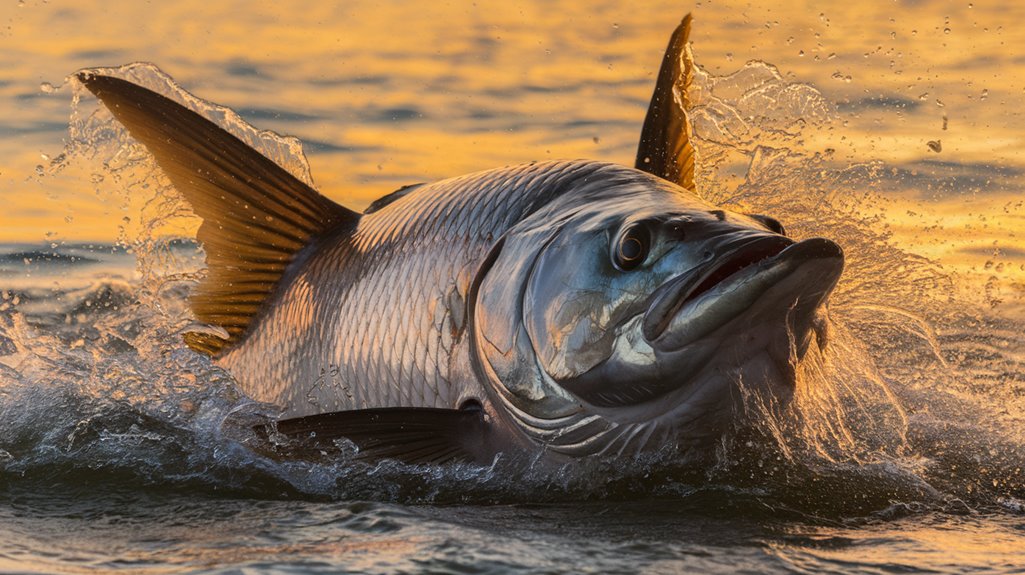You'll find the Atlantic tarpon (Megalops atlanticus) stands apart from other fish species through its unmistakable morphological features. The reflective scales, measuring up to 3 inches in diameter, create a distinctive silvery appearance that's earned these fish their "Silver King" moniker. While you might mistake them for barracuda at first glance, their upturned mouth and elongated dorsal fin ray provide definitive identification markers. Yet these visible characteristics only scratch the surface of their remarkable adaptations.
- Key Takeaways
- The Silver King's Distinctive Physical Features
- Habitat Preferences and Global Distribution
- Feeding Patterns and Hunting Behavior
- Growth Stages and Life Cycle
- Sport Fishing Impact and Conservation
- Vision Adaptations and Sensory Abilities
- Natural Predators and Defense Mechanisms
- Age and Size Records in Different Regions
- Frequently Asked Questions
- Conclusion
Key Takeaways
- Tarpon have distinctive massive reflective scales up to three inches across, with a greenish-blue dorsal area transitioning to silver sides.
- The extended final ray of the dorsal fin reaching near the tail is a unique identifying feature often confused with other species.
- Contrary to popular belief, tarpon see red lures as black since they cannot process longer wavelengths in their visual spectrum.
- Adult tarpon develop UV light sensitivity and enhanced blue/purple perception, unlike juveniles which primarily detect dark blue and green.
- The upturned mouth with a bony plate in the lower jaw distinguishes tarpon from similar-looking species like mullet or ladyfish.
The Silver King's Distinctive Physical Features

The majestic tarpon's physical features make it one of the most recognizable game fish in coastal waters. You'll immediately notice the silver king's massive reflective scales, measuring up to three inches across, which create its signature metallic sheen. The elongated body displays a greenish-blue dorsal region shifting to brilliant silver sides, providing effective camouflage in varying water conditions.
When you're examining a tarpon's head, you'll spot its distinctive upturned mouth with a bony plate in the lower jaw, essential for its predatory success. The dorsal fin's extended final ray, reaching near the tail, sets it apart from other species. You'll also find that the tarpon's unique swim bladder allows it to gulp air, enhancing its adaptability in different environments.
Habitat Preferences and Global Distribution
You'll find tarpon distributed throughout the Atlantic Ocean's warmer coastal waters, spanning from Senegal to Argentina and reaching as far north as Nova Scotia. These migratory fish concentrate in estuarine environments and mangrove-lined lagoons at depths between 10-60 feet, where they access prime feeding grounds and spawning sites. During warmer months, you can observe significant populations in subtropical regions like Tampa Bay and the Florida Keys, where they capitalize on the ideal breeding conditions in protected backwaters and bays.
Global Migration Patterns
Throughout the Atlantic Ocean's vast expanse, tarpon demonstrate remarkable migration patterns that span both eastern and western regions. You'll find these fish moving between Senegal and Argentina in the eastern Atlantic, while in the western waters, they navigate from Nova Scotia through the Gulf of Mexico and South Florida.
During spawning season, primarily May through July, tarpon leave their preferred warmer coastal waters and migrate offshore. These annual movements create prime opportunities for recreational anglers, particularly in areas like Tampa Bay, where seasonal concentrations peak. While capable of year-round spawning, their most significant migrations align with specific breeding cycles. Their remarkable adaptability allows them to thrive in various habitats, from mangrove-lined estuaries to offshore waters, making regular movements between these environments as conditions and life cycles demand.
Coastal Water Requirements
Located mainly in warm coastal waters between 25°N and 25°S latitude, tarpon demonstrate distinct habitat preferences across their Atlantic distribution range. You'll find these fish inhabiting shallow coastal waters from Nova Scotia to Argentina, with particularly dense populations in Florida and the Caribbean regions.
Juvenile tarpon thrive specifically in backbay environments and protected estuarine waters, where they've adapted to low-oxygen conditions. These younger fish utilize mangrove-lined lagoons and seagrass beds as essential nursery grounds. During spawning seasons, which occur from late spring through summer, you'll observe tarpon migrating to offshore waters. Their habitat selection varies by life stage, with adults preferring deeper coastal waters while maintaining access to shallow feeding grounds. This species' distribution patterns highlight their reliance on diverse, interconnected marine ecosystems.
Feeding Patterns and Hunting Behavior

You'll observe that tarpon employ highly specialized nocturnal hunting tactics, utilizing their advanced ultraviolet light detection capabilities to locate prey in low-visibility conditions. Their strategic suction-strike method involves approaching prey from below with closed mouths and flared gill covers, creating a vacuum effect that efficiently captures mid-water prey species. When pursuing their preferred prey of mullets and shrimp, tarpon's upturned mouths and minute dentition enable them to consume their targets whole, making them effective apex predators in their marine ecosystem.
Nocturnal Predatory Tactics
When darkness falls, tarpon transform into highly efficient nocturnal predators, equipped with specialized adaptations for hunting in low-light conditions. You'll find these carnivorous fish utilizing their enhanced vision capabilities, including ultraviolet light detection, to locate prey during nighttime hours. Their distinctive feeding strategy involves a precise suction strike, approaching prey from below before creating a vacuum with flared gill covers. During nocturnal hunts, you'll observe tarpon positioning themselves in shadowed areas beneath structures, employing ambush tactics to capture unsuspecting prey. Their remarkable swimming speeds of up to 35 mph enable effective pursuit of mid-water targets like mullets and shrimp. While adult tarpon focus on larger prey items, juveniles target smaller fare such as zooplankton, insects, and small fish.
Prey Selection Methods
Tarpon's prey selection methods demonstrate a remarkable evolution across their life stages, with distinct feeding patterns emerging between juveniles and adults. You'll observe juvenile tarpon under 40 inches primarily feed on zooplankton and insects, while adult tarpon prey on mid-water prey, including mullets and shrimp. Their feeding behavior relies heavily on vision adaptations, with juveniles detecting dark blue and green wavelengths, while adults can perceive purples, blues, and ultraviolet light.
When fishing for tarpon, you'll notice their characteristic suction strike method, where they approach prey from below with closed mouths. They'll suddenly flare their gill covers to create suction, enabling them to swallow prey whole despite having minute teeth. This efficient hunting technique allows them to feed on diverse prey across various habitats throughout their lifecycle.
Growth Stages and Life Cycle
The remarkable life cycle of tarpon begins with a microscopic egg that develops into a distinctive leptocephalus larva, lasting approximately one month until reaching 3-4 inches in length. During their juvenile stage, tarpon adapt to estuarine environments where they've developed the unique ability to gulp air through their swim bladder, enabling survival in low-oxygen waters.
As sub-adults, from 2 years onward, they'll expand their diet while developing adult characteristics. Female tarpons reach sexual maturity around 10 years, while males mature earlier at 6-7 years. Once mature, females can release up to 12 million eggs during offshore spawning events in late spring through summer. These remarkable fish can live beyond 80 years, making them one of the longest-living species in their habitat.
Sport Fishing Impact and Conservation

Due to their impressive size and acrobatic displays, tarpon have become a cornerstone of Florida's recreational fishing industry, generating substantial economic impact while necessitating careful conservation measures.
You'll find strict regulations in place, particularly in the Florida Keys, where commercial harvest is prohibited. Anglers must purchase a $50 tarpon tag before possessing the fish, promoting catch and release fishing practices. These conservation efforts have proven effective, with documented kills dropping from 342 in 1989 to 70 in 1998. While tarpon flesh remains a delicacy in Panama and the West Indies, Florida prioritizes their recreational value. Current research focuses on post-release survival rates to combat threats like habitat loss and overfishing, as these species are especially vulnerable due to their slow growth patterns and delayed maturation.
Vision Adaptations and Sensory Abilities
Equipped with sophisticated visual adaptations, tarpon demonstrate remarkable sensory capabilities that evolve throughout their life stages. Their large eyes contain a specialized tapetum layer that enhances visual capabilities in low-light conditions, enabling efficient predation during day and night cycles. You'll find distinct differences between juvenile and adult tarpon's color perception: younger specimens primarily detect dark blue and green wavelengths, while adults develop sensitivity to UV light. As tarpon mature, their visual spectrum shifts from green sensitivity toward enhanced perception of purples and blues, optimizing their hunting strategy. You won't find them responding to red lures, as they're unable to process longer wavelengths in marine environments – these appear black to their sensory system, a fact confirmed through both scientific research and angling experience.
Natural Predators and Defense Mechanisms
While tarpon possess remarkable visual capabilities for hunting, they must also defend against their own predators throughout their life cycle. Adult tarpon face constant threats from bull and hammerhead sharks, while juvenile tarpon must evade piscivorous birds in shallow waters. The species' larvae and eggs are particularly vulnerable to predation by small fishes and zooplankton.
You'll find that tarpon have evolved sophisticated defense mechanisms to counter these natural predators. Their most distinctive adaptation is the ability to leap up to 10 feet out of the water, effectively evading threats and dislodging hooks. Additionally, their specialized swim bladder allows them to gulp air from the surface, enabling survival in low-oxygen environments where predators can't follow. This unique combination of defenses helps guarantee their survival across various life stages and habitats.
Age and Size Records in Different Regions
The remarkable growth potential of tarpon manifests in record-breaking specimens across different regions, with the International Game Fish Association (IGFA) documenting a peak weight of 286 pounds in 2003. You'll find female tarpons reaching sexual maturity at 10 years old when they're about 4.5 feet long, while males mature earlier at approximately 4 feet.
In different habitats and coastal waters, large tarpon can reach lengths exceeding 8 feet, with some specimens reportedly weighing over 300 pounds. Female tarpons demonstrate significant growth potential and longevity, living up to 50 years compared to males' 30-year lifespan. These growth patterns vary by region, with local environmental conditions influencing maximum sizes and development rates across their distribution range.
Frequently Asked Questions
What Is the Appearance of a Tarpon?
You'll recognize Megalops atlanticus by its greenish-blue dorsal coloring shifting to silver flanks, upturned mouth with bony plate, 4-8 foot length, and 3-inch armored scales.
What Are the Characteristics of a Tarpon?
You'll find tarpon possess elongated jaws, 3-inch armored scales, and a distinctive dorsal fin. They'll reach 4-8 feet in length, weigh 60-280 pounds, with bluish-green coloring and silver sides.
What Does a Tarpon Fish Look Like?
You'll spot a tarpon by its massive silver scales, 8-foot elongated body, greenish-blue dorsal coloring, and distinctive upturned mouth. Its extended dorsal fin ray reaches near its tail.
What's so Special About Tarpon?
You'll find tarpon remarkable for their 50+ year lifespan, 286-pound record size, ultraviolet vision capabilities, and specialized suction-feeding mechanism that enables whole-prey consumption in both diurnal and nocturnal conditions.
Conclusion
You'll find that Megalops atlanticus exhibits remarkable adaptations, with scales reaching 8-10 cm in diameter and retinal cone cells that shift from 500nm to 620nm sensitivity during maturation. Their distinctive physiology includes a swim bladder functioning as a pseudo-lung, enabling atmospheric oxygen absorption. When you're identifying tarpon, focus on their superior maxillary extension and 40-56 lateral line scales, which differentiate them from superficially similar species.

